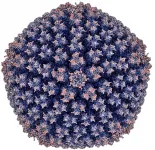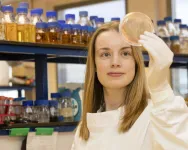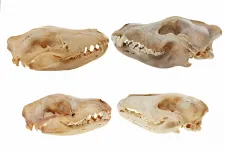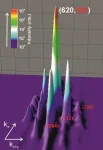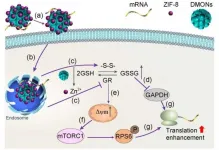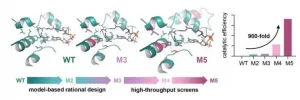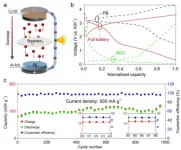(Press-News.org) Special Issue: Tumor Microenvironment and Drug Delivery
Guest Editors: Huile Gao, West China School of Pharmacy, Sichuan University, Chengdu, China; Zhiqing Pang, Fudan University, Shanghai, China and Wei He, China Pharmaceutical University, Nanjing, China
The Journal of the Institute of Materia Medica, the Chinese Academy of Medical Sciences and the Chinese Pharmaceutical Association, Acta Pharmaceutica Sinica B (APSB) is a monthly journal, in English, which publishes significant original research articles, rapid communications and high quality reviews of recent advances in all areas of pharmaceutical sciences -- including pharmacology, pharmaceutics, medicinal chemistry, natural products, pharmacognosy, pharmaceutical analysis and pharmacokinetics.
Acta Pharmaceutica Sinica B Volume 10, Issue 11 is a special issue on tumor microenvironment and drug delivery. Several drug delivery systems to treat cancer are available to the market with many other promising candidates currently under investigation. The complex tumor microenvironment greatly influences drug delivery efficiency of these systems to tumors, while the tumor microenvironment can be leveraged to design smart drug delivery systems for improving tumor drug delivery. Knowledge about tumor microenvironment and its impact to tumor drug delivery are critically important for improving the drug delivery efficiency to tumors.
Featured papers in this issue are:
The role of tumor-associated macrophages (TAMs) in tumor progression and relevant advance in targeted therapy by authors Qiyao Yang, Ningning Guo, Yi Zhou, Jiejian Chen, Qichun Wei and Min Han. Tumor-associated macrophages (TAMs) as a major part in the tumor environment (TME) are associated with the progression of tumor. In this review article, the authors summarize the roles TAMs play and some TAM targeting strategies. The article provides some perspectives about drug targets for TAMs and some potential combination therapies.
Dual-targeting nanovesicles enhance specificity to dynamic tumor cells in vitro and in vivo via manipulation of ?v?3-ligand binding by authors Yang Song, Xiangfu Guo, Jijun Fu, Bing He Xueqing Wang, Wenbing Dai, Hua Zhang and Qiang Zhang. The authors investigated a doxorubicin-loaded lipid vesicle targeted to dynamic tumor cells in flowing blood system. RGDm7 and DT4, helped lipid vesicle bind with ?v?3 on the surface of tumor cell in a "fast-binding/slow-unbinding" way. Meanwhile, DT4 led the lipid vesicle to dissolve near nucleus and promoted the cytotoxicity of doxorubicin.
Precise delivery of obeticholic acid via nanoapproach for triggering natural killer T cell-mediated liver cancer immunotherapy by authors Guofeng Ji, Lushun Ma, Haochen Yao, Sheng Ma, Xinghui Si, Yalin Wang, Xin Bao, Lili Ma, Fangfang Chen, Chong Ma, Leaf Huang, Xuedong Fang and Wantong Song. The authors discuss how nanoemulsion-loaded obeticholic acid (OCA-NE) accumulates in liver sinusoidal endothelial cells (LSECs) and triggers robust natural killer T (NKT) cell-mediated liver cancer therapy.
Other articles published in the issue include:
Editorial
Editorial of Special Issue on Tumor Microenvironment and Drug Delivery
Huile Gao, Zhiqing Pang, Wei He
Review articles
Manipulation of immune?vascular crosstalk: new strategies towards cancer treatment
Yang Zhao, Xiangrong Yu, Jia Li
The progress and perspective of nanoparticle-enabled tumor metastasis treatment
Wei Zhang, Fei Wang, Chuan Hu, Yang Zhou, Huile Gao, Jiang Hu
Nanomedicines modulating tumor immunosuppressive cells to enhance cancer immunotherapy
Yuefei Zhu, Xiangrong Yu, Soracha D. Thamphiwatana, Ying Zheng, Zhiqing Pang
Small interfering RNA for cancer treatment: overcoming hurdles in delivery
Nitin Bharat Charbe, Nikhil D. Amnerkar, B. Ramesh, Murtaza M. Tambuwala, Hamid A. Bakshi, Alaa A.A. Aljabali, Saurabh C. Khadse, Rajendran Satheeshkumar, Saurabh Satija, Meenu Metha, Dinesh Kumar Chellappan, Garima Shrivastava, Gaurav Gupta, Poonam Negi, Kamal Dua, Flavia C. Zacconi
Nanomedicine-based drug delivery towards tumor biological and immunological microenvironment
Jin Li, Diane J. Burgess
Novel agents targeting leukemia cells and immune microenvironment for prevention and treatment of relapse of acute myeloid leukemia after allogeneic hematopoietic stem cell transplantation
Wei Shi, Weiwei Jin, Linghui Xia, Yu Hu
Natural products remodel cancer-associated fibroblasts in desmoplastic tumors
Rujing Chen, Leaf Huang, Kaili Hu
Original Articles
Tailored core?shell dual metal-organic frameworks as a versatile nanomotor for effective synergistic antitumor therapy
Biyuan Wu, Jintao Fu, Yixian Zhou, Sulan Luo, Yiting Zhao, Guilan Quan, Xin Pan, Chuanbin Wu
Molecular engineering of antibodies for site-specific conjugation to lipid polydopamine hybrid nanoparticles
Hobin Yang, Quoc-Viet Le, Gayong Shim, Yu-Kyoung Oh, Young Kee Shin
Injectable thermo-responsive nano-hydrogel loading triptolide for the anti-breast cancer enhancement via localized treatment based on "two strikes" effects
Yaoyao Luo, Jingjing Li, Yichen Hu, Fei Gao, George Pak-Heng Leung, Funeng Geng, Chaomei Fu, Jinming Zhang
Short Communication
Phospholipid membrane-decorated deep-penetrated nanocatalase relieve tumor hypoxia to enhance chemo-photodynamic therapy
Junjing Yin, Haiqiang Cao, Hong Wang, Kaoxiang Sun, Yaping Li, Zhiwen Zhang
INFORMATION:
For more information please visit https://www.journals.elsevier.com/acta-pharmaceutica-sinica-b/
Editorial Board: https://www.journals.elsevier.com/acta-pharmaceutica-sinica-b/editorial-board
APSB is available on ScienceDirect.
Submissions to APSB may be made using Editorial Manager®.
CiteScore: 10.5
Impact Factor: 7.097
5-Year Impact Factor: 7.865
Source Normalized Impact per Paper (SNIP): 2.210
SCImago Journal Rank (SJR): 1.792
ISSN 2211-3835
The Journal of the Institute of Materia Medica, the Chinese Academy of Medical Sciences and the Chinese Pharmaceutical Association, Acta Pharmaceutica Sinica B (APSB) is a monthly journal, in English, which publishes significant original research articles, rapid communications and high quality reviews of recent advances in all areas of pharmaceutical sciences -- including pharmacology, pharmaceutics, medicinal chemistry, natural products, pharmacognosy, pharmaceutical analysis and pharmacokinetics.
Featured papers in this issue are:
Berberine diminishes cancer cell PD-L1 expression and facilitates antitumor immunity via inhibiting the deubiquitination activity of CSN5 by authors Yang Liu, Xiaojia Liu, Na Zhang, Mingxiao Yin, Jingwen Dong, Qingxuan ...
"The findings provide an increased understanding of how the virus gets through the stomach and intestinal system. Continued research can provide answers to whether this property can also be used to create vaccines that ride 'free rides' and thus be given in edible form instead of as syringes," says Lars-Anders Carlson, researcher at Umeå University.
The virus that the researchers have studied is a so-called enteric adenovirus. It has recently been clarified that enteric adenoviruses are one of the most important factors behind diarrhea among infants, and they are estimated to kill more than 50,000 children under the age of five each year, ...
Researchers from Trinity College Dublin have discovered a key mechanism underlying bacterial skin colonisation in atopic dermatitis, which affects millions around the globe.
Atopic dermatitis (AD, also called commonly eczema) is the most common chronic inflammatory skin disorder in children, affecting 15-20% of people in childhood. During disease flares, patients experience painful inflamed skin lesions accompanied by intense itch and recurrent skin infection.
The bacterium Staphylococcus aureus (S. aureus) thrives on skin affected by AD, increasing inflammation and worsening AD symptoms. Although a small number of therapies are available at present for patients with moderate ...
Leading research at Newcastle University has been used to shape how dentistry can be carried out safely during the Covid-19 pandemic by mitigating the risks of dental aerosols.
It is well known that coronavirus can spread in airborne particles, moving around rooms to infect people, and this has been a major consideration when looking into patient and clinician safety.
Research, published in the Journal of Dentistry, has led the way in helping shape national clinical guidance for the profession to work effectively under extremely challenging circumstances.
The findings have been used by the Dental Schools' Council, Association of Dental Hospitals and the Scottish Dental Clinical Effectiveness ...
Micro-CT scanning and digital reconstructions have been used to compare the skulls of the Tasmanian tiger (thylacine) and wolf across their early development and into adulthood, establishing that not only did the thylacine resemble the wolf as adults, but also as newborns and juveniles.
"Remarkably, the Tasmanian tiger pups were more similar to wolf pups than to other closely related marsupials," Professor Andrew Pask from the University of Melbourne said.
The collaborative study with Flinders University and Museums Victoria complement earlier findings that thylacine and wolf have evolved ...
Artificial intelligence and machine learning are already an integral part of our everyday lives online. For example, search engines such as Google use intelligent ranking algorithms and video streaming services such as Netflix use machine learning to personalize movie recommendations.
As the demands for AI online continue to grow, so does the need to speed up AI performance and find ways to reduce its energy consumption.
Now a University of Washington-led team has come up with a system that could help: an optical computing core prototype that uses phase-change material. This system is fast, energy efficient and capable of accelerating ...
Topological materials are characterised by unique electronic and physical properties that are determined by the underlying topology of their electronic systems. Scientists from the Max Planck Institutes for Microstructure Physics (Halle) and for Chemical Physics of Solids (Dresden) have now discovered that (TaSe4)2I is the first material in which a charge density wave induces a phase transition between the semimetal to insulator state.
An international team of scientists at the Max Planck Institute for Microstructure Physics, Halle (Saale), the Max Planck Institute for Chemical Physics of Solids ...
Delivery of genetic molecules such as mRNA into cells is vital with important applications such as vaccine development. Various agents have been developed for mRNA delivery. However, conventional mRNA nanocarriers mainly focus on their physical interaction with mRNA molecules, or protection / delivery of mRNA, such as adjusting physical properties of nanocarriers to control binding with mRNA or cellular uptake. Moreover, effective mRNA delivery in hard-to-transfect APCs remains a challenge. The hard-to-transfect nature in APCs is partly attributed to the suppressed mRNA translation associated with the intrinsic high intracellular glutathione (GSH) level. Thus, ...
Photorespiration is a highly energy consuming process in plants that leads to the release of previously fixed CO2. Thus, engineering this metabolic process is a key approach for improvement of crop yield and for meeting the challenge of ever-rising CO2 levels in the atmosphere. Researchers led by Tobias Erb from the Max Planck Institute for Terrestrial Microbiology in Marburg, Germany, have now succeeded in engineering the TaCo pathway, a synthetic photorespiratory bypass. This new-to-nature metabolic connection opens up new possibilities of CO2 fixation ...
With the rapid development of smart portable electronics and electric vehicles, the consumption of lithium resource will increase dramatically and the cost of lithium-ion batteries (LIBs) may increase significantly in the future. In addition, the shortage (0.0017 wt% in the earth's crust) and uneven crustal distribution of lithium also limit its further development and application. As potassium (2.7 wt% in the earth's crust) have properties similar to lithium and abundant reserves. Therefore, as an alternative to LIBs, potassium ion batteries (PIBs) have become the focus of research. Potassium (2.92 V vs. ...


